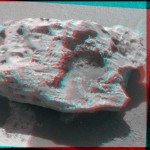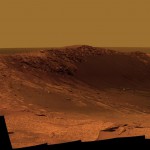Throughout our history there have been many missions to Mars, our small red neighboring planet. Two of these missions have been to scope out the actual surface of Mars. The two rovers are called Opportunity and Curiosity. Although there have been other missions to Mars, these two are interesting because while other missions have shown the atmosphere and overall composition of Mars, the rovers have shown what everyone finds interesting: what is actually on Mars and they are still functioning to this day.
The first question you might ask is “Why send a rover to Mars?” Well normally you would think it’s to find some sort of alien life form and see if they would allow us to trade or eventually live on the planet. However that is not the reason these two rovers went there. Many scientists believe that when Mars was first created it wasn’t the barren wasteland that we come to associate it with now. Instead it contained an oceans worth of water and it was similar to the composition of Earth. Due to Mars being smaller than Earth when it was created it cooled a lot faster and there was a decrease in volcanic activity. This meant that there was less CO2 in the air which caused the surface to cool. This is called the reverse runaway greenhouse effect. So the rovers had a simple job: To examine the planet and rock samples to see what happened to the water and to find out if the planet was habitable when there was a source of water.
On July 7th 2003 the Opportunity Mars Exploration Rover was launched into space and landed near the equator of Mars in the Meridiana Planum called the Eagle Crater on January 25th 2004. The rover was only supposed to stay active for 92 Earth days however it exceeded that time frame by about eight years and it is still active to this day. It also exceeded the lifespan of its twin rover that landed on Mars three weeks earlier Spirit. The Opportunity was equipped with a panoramic camera that examines the texture, color, mineralogy and structure of the local terrain, a navigation camera that helped it to navigate and drive. On its arms it had a magnet to collect magnetic dust particles and an X-Ray spectrometer to examine the abundance of elements that make up the minerals. The rover itself was solar powered, drove with six wheels and was made of pieces from the fallen World Trade Center. So far the rover has been able to make key discoveries in the time that it has been active.
When the Opportunity landed in Eagle Crater in 2004 it could not begin its analysis of the environment because it happened to land in the darkest crater on Mars at the time. Because of this the rover had to wait two weeks before it could properly analyze and navigate through its surroundings. Around April 2004 the Opportunity found the Endurance crater and explored it for six months. Although there were many setbacks during this time because of inconclusive test, the rover was still able to make a huge discovery towards the existence of water on Mars. The rover found that while water was in the area of the Endurance crater it wasn’t a constant flow of water, instead the rocks showed that the water came in floods periodically. After leaving the crater the rover then continued to its heat shield and found the first meteorite ever found on another planet which was named Heat Shield Rock.
However after this discovery the rover began to move South and it ran into many problems that could have ended its mission. In April of 2005 the rover dug itself into a sand dune locking all of its wheels in sand. Because of a chance that the rover could be permanently disabled if it was remote controlled NASA had to run simulations in order to figure out a way to free the rover. This process to find out a way took 2 months before the rover was finally freed in June of 2005. This didn’t stop the mission as Opportunity continued to move south. A few months later there was a dust storm on Mars that stopped Opportunity from being able to take pictures. After the dust was cleared up it was found that the arm of the rover became slower because of all of the dust. This problem took another two weeks to fix and forced the rover to drive with the left arm always out top prevent further stalling. However this just revealed another problem that the rover would face. Since the shoulder joint was always out it continued to face the full effects of the temperature. Because of the changes in the winter the shoulder would become extremely hot during the day and extremely cold at night. Because of this the motor on the rover began to wear out fast. To counter this, engineers had to program the rover to direct as much of its current as it can in order to keep the arm in a useable position where it won’t wear out as fast. After these problems were solved the rover was able to continue its mission by programming it to drive safely while keeping the arm in front of it. Opportunity was able to make a huge discovery toward the existence of water on Mars in its time surveying the Eagle Crater and it continues to make mini discoveries to this day.
The next rover that is still on Mars is called Curiosity. It was launched recently on November 26th 2011 from Cape Canaveral and landed on Mars on August 6 2012 in the Gale Crater. It is expected to stay on Mars for 2 years. This mission had a different goal than the one of the Opportunity. The goal of Curiosity was to find if Mars could have ever supported life and to study the climate and geography of Mars to send back information that can prepare for human exploration.
Because of the previous rovers that were sent to Mars, engineers were more prepared to deal with some of the elements that could affect the rover. This was shown in the way that the Curiosity was built. Curiosity is equipped with a radioisotope thermoelectric generator as a power source.
This generator produces electricity through the decay of plutonium. It also has a heat rejection system to prevent the same problems that happened with the Opportunity.
Since the Curiosity was recently launched there isn’t much to say about what has been found. However there was a significant moment in the mission which was the landing of the Curiosity rover. This event was called the Seven Minutes of Terror. This is the seven minutes it took for the rover to pass through the Martian atmosphere and land safely on the surface. In order for the rover to land safe, it had to be programmed with extremely precise commands so that it would land in the designated spot and the rover wouldn’t be destroyed in the landing or the atmosphere.
Right before the shuttle enters the atmosphere it has to separate from the rover and allow it to begin its descent. As soon as the rover hits the atmosphere the timer begins and the rover has those seven minutes to go through each of the steps that it has to take to hit the ground safely. Because the atmosphere on Mars is one hundred times thinner than the one on Earth it doesn’t slow down the rover enough to give it a safe landing so it is still travelling at incredible speeds. In order to slow down Curiosity a large parachute, the biggest one made by the engineers to date, had to be used in order for the ship to slow down to about 200 mph. As soon as the parachute was deployed the heat shield also had to be release to make the parachute more effective. However since the parachute would not slow down the rover enough, it had to be released and instead be replaced with rockets to further slowdown the descent. The rockets also had to be programmed to shift the rover away from the runaway parachute to prevent a collision as it was slowing down. Although the rockets could have safely lowered the speed to prevent a dangerous collision with the surface of Mars, another step was needed because the rockets would have produced a huge dust cloud near the surface which could have possibly damaged the inner mechanisms of the Curiosity. To counter this, the actual rover was lowered using what was called the Skycrane Maneuver. This means that at about ten meters above the surface the actual rover was lowered using a tether. This would prevent the rockets from producing the dust cloud and ensure that the rover landed on the surface safely. After the Curiosity safely landed the rockets had to fly off in another direction to prevent a potential collision that could damage the rover. All of this had to be executed in the span of seven minutes. Also it would take another seven minutes for this information to be sent back to NASA. So in this time the engineers and technicians just had to hope that everything went off precisely as planned.
Both the Curiosity and the Opportunity continue to function on Mars to this day. The Curiosity has not found much information relating to its mission goals but it continues to search and hopefully one day it finds out if life on Mars was ever possible. The Opportunity however continues to function although it is eight years past its 90 day time limit. This mission has proven that there was once water on Mars at least near the Endurance crater that came in waves and didn’t stay permanently. Hopefully these rovers continue to make bigger discoveries that can not only prepare for a human mission to Mars but also opens up a way for them to possibly study other planets.
These are pictures that are related to the missions to Mars. From left to right we have the heat shield rock, then its the Santa Maria Crater (as taken by Opportunity), next is a pictuire of Curiosity during its test run and finally a picture of the white- water lake rock taken by Opportunity.
This is a video showing Curiosity’s trip from its launch to its landing on Mars.
References
http://www.nasa.gov/mission_pages/mer/multimedia/gallery/pia13794.html <Picture of Santa Maria Crater>
http://en.wikipedia.org/wiki/Opportunity_rover#Shoulder_troubles < Information about Opportunity and its mission>
http://www.nasa.gov/mission_pages/mer/images/mer20090806.html < Picture of Heat Shield Rock>
http://en.wikipedia.org/wiki/Curiosity_rover <Information about Curiosity’s Design>
http://www.nasa.gov/multimedia/imagegallery/image_feature_1975.html <Picture of curiosity>
http://en.wikipedia.org/wiki/Seven_minutes_of_terror#Entry.2C_Descent_and_Landing_.28EDL.29 <Information about the 7 minutes of Terror>
http://www.jpl.nasa.gov/video/index.php?id=1090 < Video of the “7 Minutes of Terror >
https://www.youtube.com/watch?v=P4boyXQuUIw <Video of Curiosity>







